5 tips for nurturing your saplings to maturity
Bringing a sapling to maturity is a rewarding journey that requires patience, knowledge, and a nurturing touch. Whether you're a gardening enthusiast, a landscape architect, or a homeowner looking to enhance your space with vibrant flora, these five tips will guide you in nurturing your saplings to robust maturity.
Understanding Your Saplings
Each sapling species has unique requirements for sunlight, water, soil type, and space. Understanding these needs is crucial for their development. Researching your specific sapling type or consulting with experts can provide valuable insights into providing the best care.
Observation is key in the early stages of growth. Pay attention to your saplings' responses to their environment, which can indicate if adjustments are needed in their care routine.
Tip 1: Proper Planting Techniques
Location is paramount for sapling health. Consider sunlight exposure, wind patterns, and proximity to other plants. Ensure the chosen spot allows for future growth, both above and below ground.
The correct planting depth is essential for root development. The hole should be as deep as the root ball and two to three times wider. Use well-draining soil and amend it with organic matter to promote healthy growth.
Tip 2: Watering Wisely
Young saplings require consistent moisture to establish their root systems. Create a watering schedule that keeps the soil moist but not waterlogged. Adjust the schedule based on rainfall, temperature, and the sapling's growth stage.
Overwatering can lead to root rot, while underwatering can stress the plant. Signs of improper watering include yellowing leaves, wilting, and stunted growth. Adjust your watering practices accordingly.
Tip 3: Mulching and Soil Management
Mulch helps retain soil moisture, regulate temperature, and suppress weeds. Apply a 2-3 inch layer around the base of the sapling, avoiding direct contact with the trunk.
Soil fertility is crucial for sapling health. Conduct a soil test to determine nutrient levels and pH balance. Amend the soil as needed to provide the necessary nutrients for your saplings.
Tip 4: Pruning and Training
Pruning is important for shaping the plant and encouraging strong structure. Prune during dormancy, removing dead or crossing branches, and thinning to improve air circulation.
Training involves directing the growth of the sapling. Use stakes and ties to support the sapling and encourage it to grow in the desired direction and shape.
Tip 5: Pest and Disease Management
Maintaining plant health is the best defense against pests and diseases. Proper spacing, clean tools, and monitoring for early signs of trouble can prevent many issues.
Be vigilant for signs of pests or disease, such as discolored leaves, spots, or damaged bark. Identify the problem and treat it promptly with appropriate measures, which may include organic or chemical treatments.






Comments (0)